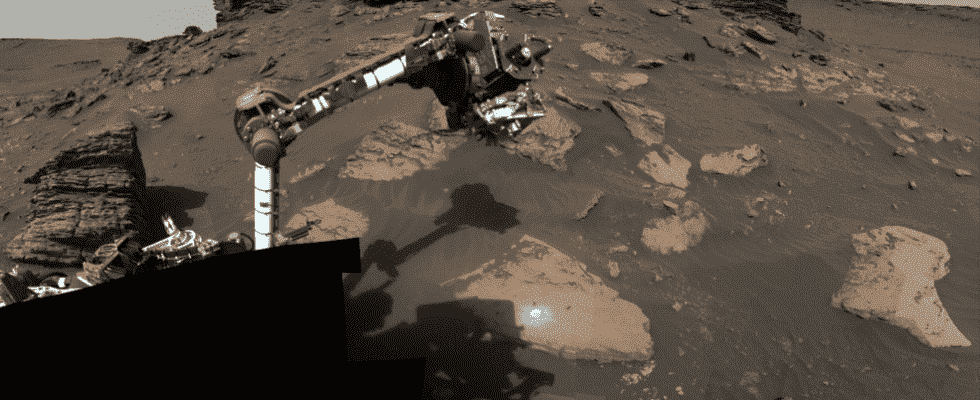NASA’s Perseverence rover puts its robotic arm to work around a rocky outcrop called “Skinner Ridge” in Mars’ Jezero Crater. NASA
NASA’s Perseverance Mars rover has unearthed new rock samples from the bottom of a Martian river. The goal? Search for signs of past life on the red planet.
Perseverance, now in its second Martian rock collection campaign, has collected four new sedimentary rock samples from the delta of an ancient river in Jezero Crater, bringing the number of samples collected since the start to 12. campaign, July 7.
NASA chose this river delta because it offered the best chance of finding signs of ancient microbial life. By ancient – if NASA ever finds proof – this microbial life would have existed around 3.5 billion years ago, when the river bed formed.
Digging at the bottom of a crater
Perseverance samples sedimentary rock from a place where the Martian river and a lake meet in Jezero Crater. The crater itself is 45 kilometers wide.
NASA’s Thomas Zurbuchen said Perseverance has already collected an “astonishing diversity” of samples that will be returned to Earth as part of the Mars sample return campaign over the next decade.
“We chose Jezero Crater for Perseverance exploration because we thought it had the best chance of yielding samples scientifically — and now we know we sent the rover to the right place,” Zurbuchen said in a statement. Press release.
A return after the departure of men for Mars?
For the return campaign, NASA plans to launch the Sample Retrieval Lander to Mars in 2028 and land it in Jezero Crater. The lander will carry a NASA-led Mars rocket and a pair of small Mars helicopters. Only when he brings the samples back to Earth will NASA scientists know for sure what they are made of.
But if SpaceX chief Elon Musk is right, humans could be on Mars before the rock samples return to Earth. Musk’s latest bet is that the departure date for humans on Mars is 2029.
Perseverance and its sister Ingenuity landed on Mars on February 18, 2021, about seven months after launching from Cape Canaveral, Florida.
rock spray
Perseverance’s first campaign explored Jezero’s soil and collected rocks that contain crystals to tell exactly when they formed. Rather than the sedimentary rocks that are currently collected, these rocks, known as igneous rocks or igneous rocks, are formed in molten lava or during volcanic activity.
The rover is equipped with a SuperCam with a rock vaporization laser that pulverized the rocks during the first campaign to determine that they were igneous rocks covering the floor of the crater.
The two different types of rock allow NASA to understand the geological past of the crater.
“Rich understanding of geological history”
“The delta, with its various sedimentary rocks, contrasts with the igneous rocks – formed by the crystallization of magma – found on the crater floor,” said Perseverance project scientist Ken Farley of Caltech in Pasadena, California.
“This juxtaposition provides us with a rich understanding of the geologic history after the crater was formed and a diverse suite of samples. For example, we found sandstone that bears grains and rock fragments created far from Jezero crater – and a limestone that includes intriguing organic compounds.”
The new evidence for organic molecules on Mars is more promising than that found in 2013 by the Curiosity rover, according to NASA.
“Conditions where life could potentially have existed”
What makes Perseverance’s findings intriguing is that the organic molecules she found are in an “area where, in the distant past, sediments and salts were deposited in a lake under conditions where the life could potentially have existed.” They were found in a section of the crater called Wildcat Ridge.
“In the distant past, the sand, mud and salts that make up the Wildcat Ridge sample today were deposited under conditions where life could potentially have thrived,” Farley said.
“The fact that organic matter was found in such sedimentary rock – known to preserve fossils of ancient life here on Earth – is significant. contents of the Wildcat Ridge sample will have to await its return to Earth for further study as part of the agency’s Mars sample return campaign.”
Source: “ZDNet.com”
